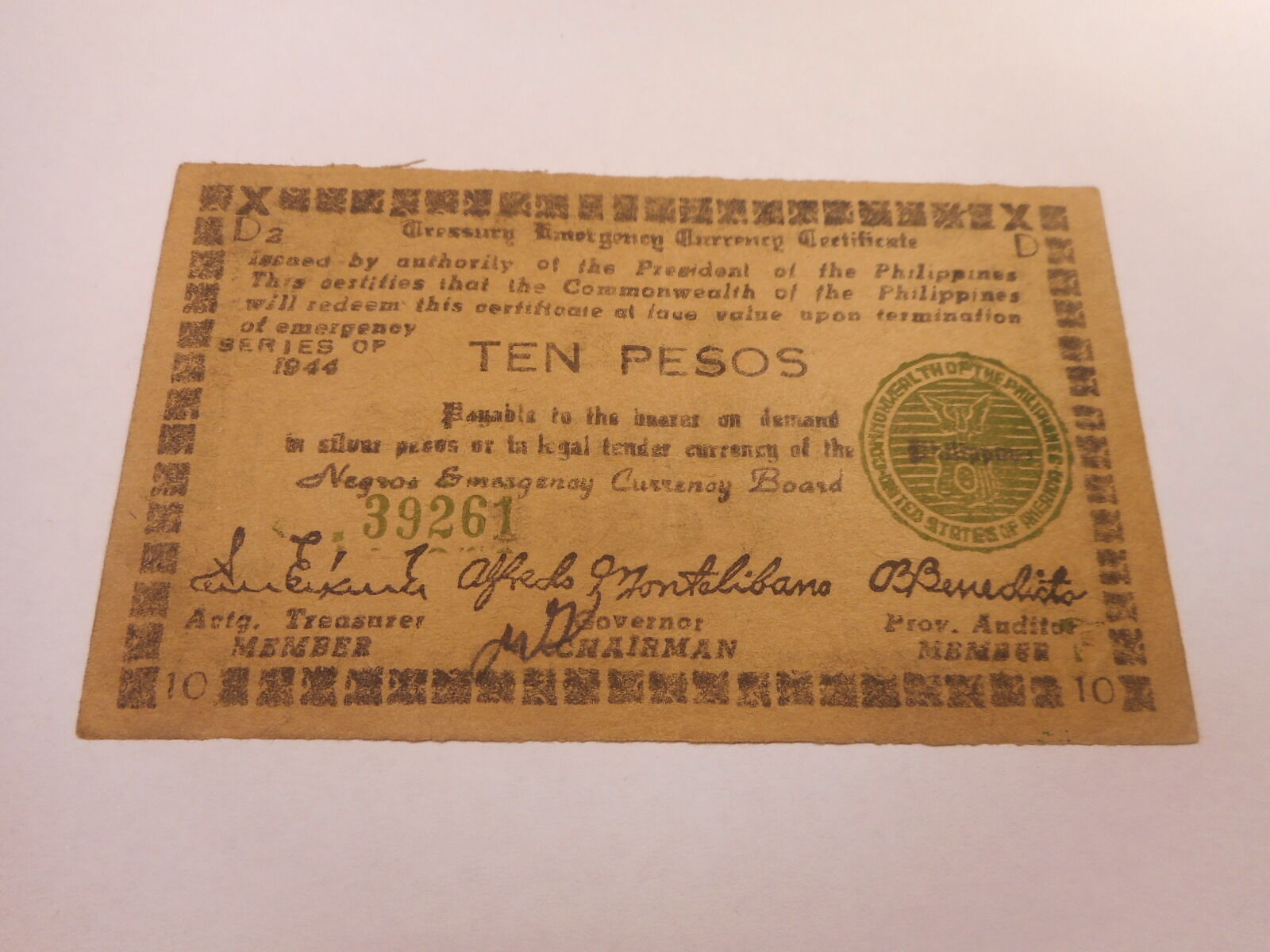-40%
5 pcs. US Philippines 1 Pesos FREE NEGROS WW2 Emergency Currency 1943-1945
$ 10.29
- Description
- Size Guide
Description
5 pcs. US Philippines 1 Peso FREE NEGROS Emergency Currency Notes Series of 1943-1945VF-XF
Condition. Guaranteed to be Genuine.
#S661 - 1 Peso,
Yellow Paper, Green Seal, Green print at the back, Series of 1943
#S668 - 1 Peso,
Red Seal, Red print at the back,Series of 1944
#S670 - 1 Peso,
Blue Seal, Blue print at the back, Series of 1944
#S672 - 1 Peso,
Red Border , Green Seal, Green print at the back, Series of 1944
#S681 - 1 Peso,
Red Border, Green Seal, Green print at the back, Series of 1945
ISLAND OF NEGROS
Free Negros
At the time of the USAFFE surrender, Negros Island was divided into five military sectors, each garrisoned by an infantry battalion. Two battalion commanders, Majors Salvador Abcede and Ernesto S. Mata, flatly refused to obey the surrender orders, instead, they withdrew into the mountains and disbanded their units. The other three battalion commanders obeyed orders and surrendered, but the majority of their men didn't. They became an army of small guerrilla bands desperately in search of leadership.
In southern Negros Occidental the guerrilla groups united under command of Maj. Salvador Abcede, white those in the north united under Maj. Ernesto S. Mata. They made contact with Col. Peralia in Panay and affiliated with his IV Philippine Corps. Peralta designated their combined units as the 72nd Division with Abcede as Commanding Officer and Mata as Chief of Staff. Both were promoted to Lieutenant Colonel rank.
Silliman University Professor Henry Roy Bell suddenly found himself leader of a guerrilla movement. His former R.O.T.C. students had even posted notices in the lowland towns, report immediately to Mr. Bell in the mountains. Bell finally located an unsurrendered officer, Maj. Placido A Ausejo to take over military command while he devoted his efforts to organization, supply and
civil affairs. As this area was dependent upon Mindanao for a large part of its food supply, they affiliated with the Mindanao-Sulu Command of Col. Fertig, who promptly sent 10,000 pesos.
Mindanao currency to aid in their finance.
In northern Negros Oriental, Lt. Col. Gabriel Gador proclaimed himself supreme commander of all Negros with the assumed rank of Major General.
On the night of January 14, 1943, the submarine USS GUDGEON surtaced off Catmon Point and landed the first Penetration Party under command of Maj. Jesus Villamor whose mission was to set up an intelligence network in the Philippines.
Villamor's next step was to establish a civil government by appointing Alfredo Montelibano, former Mayor at Bacolod, as Governor of Free Negros. This appointment was confirmed by President Quezon on June 9. 1943 when he designated Montelibano Governor of the Province of Negros, consisting of Negros Occidental, Negros Oriental and the sub-province at Sequijor.
To finance the new government. Governor Montelibano borrowed 700,000 pesos from wealthy plantation owners until permission could be obtained from President Quezon to print emergency currency.Since the Members of pre-surrender currency committees were all in Japanese controlled cities, President Quezon on July 11, 1943 created the Negros Emergency Currency Board composed of the following officials of the newly organized government: Governor Alfredo Montelibano as Chairman, with Acting Provincial Treasurer Pedro Elizalde and Provincial Auditor Alfredo Benedicta as Members.
The Currency Board had not been authorized to print any currency, but Montelibano recommended: One hundred thousand monthly needs of Civil Government, fifty thousand monthly to be used for redemption of mutilated notes, and one million pesos for a revolving fund, army is asking one million monthly.
Quezon immediately approved the recommendations but stipulated the amount for the army as being subject to MacArthur's approval. Despite numerous requests, MacArthur would not commit any specified amount. And after liberation MacArthur would deny any responsibility for redemption of currency on the grounds that he had not given his approval.
Printing got underway on September 18, 1943 in a secret location near Pagnatangan. Except for signature cuts and seals, all printing was done from standard metal type. On May 31, 1944 a second press was set up at Totong. This press printed only 1 Peso notes (#S668-5671). Also, on
June 1, 1944 Acting Provincial Auditor Nicasio Villarin replaced Benedicta as a Member of the Currency Board, but for the balance of 1944 all notes continued to be printed with Benedicta's signature. The 1945 series has Villarin's signature.
Almost any type of paper available was used for printing. The greater portion of it was derived from commercially manufactured brown paper bags. The white paper used at Tolong was brought
in by submarine.
Printing operations ended on May 8, 1945. By that time the astounding total of 40,128,539
pesos had been printed, of which all but 8,346,000 had been issued. Unissued notes were ordered destroyed.
There are several varieties of seals, used indiscriminately. There are also variations in the type set-up for dates. Numerous different clerks were employed in the task of initialing each note after it was printed. In giving serial numbers only those reported as having been issued are included, with mention where necessary of those reportedly destroyed.
(taken from Krause World Paper Money Catalogue)
ON GRADING
The grade I gave is just my opinion and may differ from others. Grading is subjective and not an exact science. Please take a look at the photo and grade it accordingly. Several subjective factors of personal preference may be considered different by others. These include paper texture, quality, color, folds, markings, stains and overall eye appeal.
-----------------------oo0oo-----------------------
Payment and Shipping
Item is as described. We will mail worldwide.
All sales are final. If you have any questions or concerns please e-mail me.
Thank you for your business.









